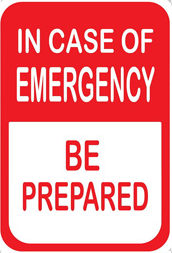With a devastating winter storm in February last year and a couple of tornadoes in the last few years, we know there is sometimes a need to survive on our own in an emergency. Help may be fast in arriving or it could take hours or even days. So, having food, water, medicine, a first-aid kit and other necessary supplies is a must.
The city of Garland has put together the following list of essentials that every household should have.
Basic essentials
- Battery-powered or hand-crank radio and NOAA Weather Radio with tone alert and extra batteries for both
- Cellphone with chargers, inverter or solar charge
- Can opener for food (if kit contains canned food)
- Dust mask, to help filter contaminated air and plastic sheeting and duct tape to shelter-in-place
- First-aid kit
- Flashlight and extra batteries
- Local maps
- Moist towelettes, garbage bags and plastic ties for personal sanitation
- Whistle to signal for help
- Wrench or pliers to turn off utilities
Vehicle emergency kit
If you’re on the road when an emergency strikes or you have to evacuate, you’ll want to have these supplies.:
- Bottled water and nonperishable food items
- First-aid kit and manual
- Flashlight with extra batteries
- Local maps
- Seasonal supplies to combat weather conditions like blankets, gloves, etc.
- Tire repair kit, booster/jumper cables, pump and flares
- White distress flag
First Aid Kit
In an emergency, a family member or you yourself may be cut, burned or suffer other injuries. If you have these basic supplies you are better prepared to help loved ones when they are hurt. Knowing how to treat minor injuries can make a difference in an emergency. Consider taking a first aid class. However, having the following things can help you stop bleeding, prevent infection and assist in decontamination.
Things you should have
- Adhesive bandages – various sizes
- Antibiotic ointment
- Burn ointment
- Cleansing agent/soap and antibiotic wipes
- Eyewash solution to flush the eyes or as general decontaminant.
- Prescribed medical supplies such as glucose and blood pressure monitoring equipment and supplies
- Prescription medications you take every day such as insulin, heart medicine and asthma inhalers. You should periodically rotate medicines to account for expiration dates
- Sterile dressings to stop bleeding
- Thermometer
- Two pairs of sterile gloves
Things that may be good to have in your kit
- Cellphone with charger
- Scissors
- Tube of petroleum jelly or other lubricants
- Tweezers
Non-prescription drugs
- Antacid
- Anti-diarrhea medication
- Aspirin or non-aspirin pain reliever
- Laxative
Water
- One gallon of water per person per day for at least three days is the minimum for drinking and sanitation. Because of the Texas heat, more water is better.
- Children, nursing mothers and sick people may need more water.
- Store water tightly in clean plastic containers such as soft drink bottles.
- Keep at least a three-day supply of water per person.
Ready to eat
- Canned juices
- Canned meats, fruits and vegetables
- Comfort foods
- Crackers
- Dried fruit
- Dry cereal or granola
- Food for infants
- High energy foods
- Non-perishable pasteurized milk
- Nuts
- Peanut butter
- Protein or fruit bars
- Vitamins
Food
- At least a three-day supply of non-perishable food.
- Select foods that require no refrigeration, preparation or cooking and little or no water.
- Pack a manual can opener and utensils.
- Avoid salty foods, as they will make you thirsty.
- Choose foods your family will eat.
Additional items to consider
- Books, games, puzzles or other activities for children
- Cash or traveler’s checks and change
- Complete change of clothing including a long-sleeved shirt, long pants and sturdy shoes. Consider additional clothing if you live in a cold-weather climate.
- Emergency reference material such as a first aid book or information from www.ready.gov.
- Feminine supplies and personal hygiene items
- Fire extinguisher
- Household chlorine bleach and medicine dropper – When diluted nine parts water to one part bleach, bleach can be used as a disinfectant. Or in an emergency, you can use it to treat water by using 16 drops of regular liquid bleach per gallon of water. Do not use scented, color-safe or bleaches with added cleaners.
- Important family documents – copies of insurance policies, identification and bank account records in a waterproof, portable container.
- Infant formula and diapers
- Matches in a waterproof container
- Mess kits, paper cups, plates and plastic utensils, paper towels
- Paper and pencil
- Pet food and extra water for your pet
- Prescription medications and glasses
- Sleeping bag or warm blanket for each person. Consider additional bedding if you live in a cold-weather climate.
- You can use the emergency financial first-aid kit (EFFAK) – developed by Operation Hope, Federal Emergency Management Agency, and Citizen Corps to help you organize your information.
Information provided by city of Garland.


